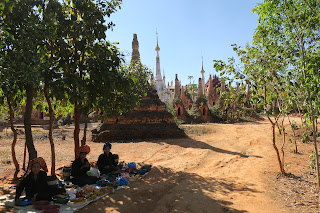The Shwe Indein Pagoda is a group of Buddhist pagodas in the village of
Indein, near Ywama and Inlay Lake in Shan State, Myanmar (Burma).
The pagodas were commissioned during the reign of King Narapatisithu. However,
tradition holds that they were built by King Ashoka (known in Burmese as
Dhammasoka), and renewed by King Anawrahta. However, there is no
archaeological evidence to support this theory.
|
Sign indicating the entrance to Shwe Indein Pagoda.
The entrance is next to the river.
-
The entrance leads to a long corridor that leads all the way to the
pagoda.
|
|
Long corridor that goes from the river to the pagoda.
This covered corridor is approximately 0.8 km (0.5 mi) long.
|
|
Ruined pagodas.
Along the way to the pagoda we found many small, ruined pagodas.
|
|
Small pagoda with mythological lion.
Chinthe is the Burmese word for 'lion'.
-
The leograph of Chinthe is a highly stylized lion commonly depicted in
Burmese iconography and architecture, especially as a pair of
guardians flanking the entrances of Buddhist pagodas and
kyaung (or Buddhist monasteries).
-
See more at
Chinthe - Wikipedia.
|
|
Buddha statue inside one of the small pagodas.
|
|
Another set of ruined pagodas.
|
|
A tree grew on top of this pagoda.
|
|
Apsara.
An apsara is a member of a class of celestial beings in Hindu and
Buddhist culture.
-
They are originally a type of female spirit of the clouds and waters,
who later plays the role of a "nymph" or "fairy".
-
They figure prominently in the sculpture, dance, literature and
painting of many Indian and Southeast Asian cultures.
-
See more at
Apsara - Wikipedia.
|
|
Green peafowl.
The green peafowl or Indonesian peafowl (Pavo muticus) is a
peafowl species native to the tropical forests of Southeast Asia and
Indochina.
- It is the national bird of Myanmar.
|
|
Woman cooking a thin bread in a bed of hot sand.
|
|
Finally we can glimpse the Shwe Indein Pagoda in the background.
The small ruined pagodas reach the Shwe Indein Pagoda that can be seen
in the background.
|
|
South entrance to Shwe Indein Pagoda.
All around Shwe Indein Pagoda there is a huge group of very small
pagodas.
|
|
Immense set of very small pagodas.
Crossing the immense set of very small pagodas to reach the eastern
entrance of Shwe Indein Pagoda.
|
|
East entrance to Shwe Indein Pagoda.
This is the main entrance to Shwe Indein Pagoda.
- This entrance is at the end of the long covered corridor.
-
Note the Buddha protected by Mucalinda on the left side of the
entrance and the Garuda on the right side of the entrance.
|
|
Buddha protected by Mucalinda on the left side of the entrance.
Mucalinda is the name of a naga, a snake-like being, who
protected the Gautama Buddha from the elements after his enlightenment.
-
It is said that six weeks after Gautama Buddha began meditating under
the Bodhi Tree, the heavens darkened for seven days, and a prodigious
rain descended.
-
However, the mighty King of Serpents, Mucalinda, came from beneath the
earth and protected with his hood the One who is the source of all
protection.
-
See more at
Mucalinda - Wikipedia.
|
|
Garuda on the right side of the entrance.
Garuda are golden-winged birds in Buddhist texts.
-
In Buddhist art, they are shown as sitting and listening to the
sermons of the Buddha.
-
They are enemies of the Nagas (snakes) and are sometimes depicted with
a serpent held between their claws.
-
Like the Hindu art, both zoomorphic (giant eagle-like bird) and
partially anthropomorphic (part bird, part human) iconography is
common across Buddhist traditions.
-
In Burmese epics, which was influenced by Hindu-Buddhist beliefs,
Garuda is known as Galone, the nemesis of the Nagas.
-
See more at
Garuda - Wikipedia.
|
|
Buddha's footprint inside the pagoda.
Buddha's footprints (Sanskrit: Buddhapada) are Buddhist icons shaped
like an imprint of Gautama Buddha's foot or both feet.
-
The veneration of the feet of gurus or deities was commonplace in
ancient India, placing one's head at or under their feet being a
ritual gesture signifying a hierarchy.
-
See more at
Buddha footprint - Wikipedia.
|
|
Golden statue of Buddha standing on a throne.
|
|
Main Buddha statue of Shwe Indein Pagoda.
The Buddha is seated with his eyes closed in mediation, his right hand
facing down with the fingertips lightly touching the ground.
-
It represents the moment when the Buddha achieved enlightenment.
|
See also
Source
Location




























